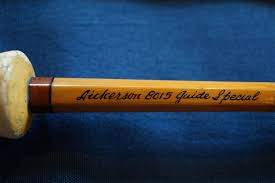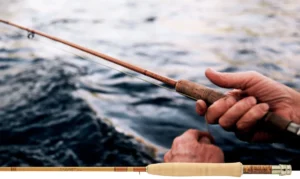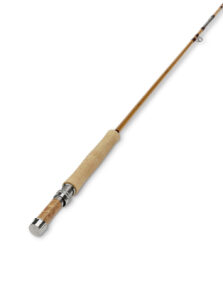
American Museum of Fly fishing amff.org
Article-At-A-Glance
-
Lyle Dickerson was a master craftsman whose rods are highly sought after for their quality and performance.
-
Authentic Dickerson rods are prized by collectors and can be identified by specific features and markings.
-
The process of making a bamboo fly rod involves meticulous selection of materials and careful handcrafting.
Lyle Dickerson: An Icon of Bamboo Fly Rods
In the world of bamboo fly rods, one name stands out: Lyle Dickerson. From his small shop in Michigan, Dickerson’s rods became the standard against which all others were measured. His rods weren’t just fishing tools; they were the embodiment of a rodmaker’s lifelong pursuit of perfection. Anglers today still seek out Dickerson rods for their exceptional performance and the timeless elegance they bring to the water.
From Michigan to Mastery
Dickerson began his journey in Detroit, working in solitude, perfecting his craft. His reputation grew, and so did the demand for his rods. Each Dickerson rod was a one-man show, reflecting his dedication to the craft. As his techniques evolved, so did the rods’ performance, making them highly coveted by anglers who recognized the difference a Dickerson rod could make in their fishing experience.
Signature Techniques and Innovations
One of Dickerson’s signature marks was his insistence on using only the finest bamboo, which he hand-selected for each rod. His mastery of tapering the bamboo strips ensured that every rod flexed and responded just right. He also designed and crafted his own ferrules, those critical connectors between rod sections, which many believe are unmatched in quality to this day. His reel seats and wraps were simple yet elegant, never distracting from the rod’s performance.
The Making of a Dickerson Rod
The making of a Dickerson rod was a labor of love and a process that could not be rushed. Let’s take a closer look at how these masterpieces were created, from the initial selection of bamboo to the final touches that made each rod a personal statement from Dickerson himself.
Choosing the Right Bamboo
It all starts with the bamboo. Not just any bamboo will do. Dickerson was known for being incredibly selective, often choosing Tonkin cane for its superior strength and flexibility. The right piece of bamboo must have a particular density and fiber structure to withstand the stresses of casting and fighting fish. It’s this foundation that sets the stage for everything that follows.
The Process: From Raw Culm to Fishing Classic
Transforming a raw bamboo culm into a classic fishing rod is a journey through time-honored techniques. The culms are first split into long, thin strips, ensuring the natural fibers run the length of the rod for maximum strength. These strips are then tapered, using a planing form that guides the hand plane in creating the rod’s unique profile. This profile is what gives each rod its action and feel—essential for the delicate presentation of a fly on the water.
Attention to Detail: Ferrules, Reel Seats, and Wraps
The ferrules of a bamboo rod are its unsung heroes, allowing the rod to be broken down for transport while maintaining a smooth action. Dickerson’s ferrules were known for their snug fit and durability, often made of nickel silver for its corrosion resistance and strength. The reel seat is another area where Dickerson’s attention to detail shone. He preferred simple, functional designs that stood the test of time, often using hardwoods and nickel silver for both beauty and functionality.
The wraps on a bamboo rod not only secure the guides to the rod but also add a touch of elegance. Dickerson’s wraps were meticulously executed, with clean lines and just the right amount of tension. The color of the thread was typically a subtle hue that complemented the natural tones of the bamboo, with fine tipping to add a distinctive accent. These small details might go unnoticed by the casual observer, but to the discerning angler, they are the hallmark of a master rodmaker’s work.
Each rod was finished with a coat of varnish, not merely for aesthetic purposes but to protect the bamboo and thread wraps from the elements. The varnish had to be applied in a dust-free environment and allowed to cure properly to ensure a hard, protective finish. It’s a painstaking process, but when you hold a finished Dickerson rod in your hands, you understand why every step is crucial.

The Dickerson Site dickersonrods.com
Identifying a Genuine Dickerson Rod
Dickerson rods carry distinctive features that can help you identify their authenticity. Look for the Dickerson signature, which is found on the rod itself or on the original tube and bag. The signature or stamp should include the model number, which corresponds to the length and weight of the rod.
Additionally, the guide spacing, wrap colors, and the unique taper of the bamboo are all indicators of a Dickerson rod. Most importantly, the ferrules should be of the step-down variety, a hallmark of Dickerson’s design. The reel seats typically feature simple, elegant hardware, and the varnish should be of the highest quality, giving the rod a deep, rich luster.
-
Check for the Dickerson stamp or signature on the rod, tube, or bag.
-
Examine the guide spacing and wrap colors for consistency with known Dickerson rods.
-
Assess the bamboo taper—subtle but distinctive in Dickerson’s rods.
-
Inspect the ferrules—they should be step-down and made of nickel silver.
-
Appreciate the quality of the reel seat and the varnish’s finish.
Remember, owning a genuine Dickerson rod is not just about having a piece of fishing equipment; it’s about owning a slice of angling history.
In Pursuit of Perfection: How to Select Your Bamboo Fly Rod
Selecting a bamboo fly rod is about finding the perfect balance between art and function. It’s a personal choice, influenced by the type of fishing you do, the species you target, and the waters you frequent. But beyond that, it’s about how the rod feels in your hand and how it connects you to the tradition of fly fishing. When you pick up a rod, pay attention to the balance, the weight, and the action. These are the attributes that will define your experience on the water.
Investing in Your Own Piece of History
Investing in a bamboo fly rod, especially one crafted by a master like Dickerson, is more than a purchase—it’s an acquisition of heritage. These rods are not just tools for catching fish; they are investments in craftsmanship and history. They can be passed down through generations, increasing in sentimental and monetary value as time goes by. When you select a bamboo rod, think of it as a legacy you’re acquiring, one that will accompany you on countless fishing adventures and, perhaps one day, will inspire another angler in your stead.
Why Bamboo Rods Are Special
Imagine standing by a serene river, the gentle whisper of the current blending with the rustling of leaves. In your hands, you hold not just a fishing rod, but a piece of art, a link to angling history. That’s the allure of bamboo fly rods. They’re more than tools; they’re heirlooms that connect us to the timeless dance between angler, rod, and fish. Bamboo rods flex in a way that feels alive, giving you a sensitivity and control that many modern materials can’t match. It’s about tradition, about doing things the way they were done when fly fishing itself was in its golden age.
Understanding the Craftsmanship
Crafting a bamboo fly rod is a symphony of precision and patience. Each rod is born from a culm of bamboo, carefully selected for its density and straightness. The bamboo is split into strips, then meticulously hand-planed to taper down to the exact dimensions needed for a balanced and responsive rod. The strips are glued together to form a blank, and then the real magic happens. The rod maker’s hands guide the formation of the rod’s soul, a process that can take weeks or even months to complete. This is craftsmanship at its finest, where every detail matters and nothing is rushed.
Keeping the Legacy Alive: Care and Maintenance
To ensure your bamboo fly rod lasts a lifetime and beyond, proper care and maintenance are essential. After each use, take the time to clean your rod with a soft, damp cloth to remove any dirt or grime. Store it in a cool, dry place, away from direct sunlight or extreme temperatures, which can cause the bamboo to warp or the varnish to crack. When assembling or disassembling the rod, do so with care to avoid damaging the delicate ferrules. And most importantly, treat the rod with the respect it deserves—it’s not just a fishing rod; it’s a piece of angling art.
Seasonal Care Tips
Like all cherished possessions, bamboo fly rods require seasonal care to maintain their optimal condition. Before storing your rod for the off-season, make sure it’s completely dry to prevent mold and mildew. Apply a light coat of rod varnish if you notice any areas where it has worn thin. This will protect the bamboo from moisture and keep it looking new. During the fishing season, regularly check the integrity of the ferrules and the tightness of the reel seat to ensure everything is secure and functional.
Restoration: When and How
Over time, even the best-cared-for bamboo rods may need restoration. This could be due to regular wear and tear or an unfortunate accident on the water. When this time comes, it’s crucial to consult with a professional who specializes in bamboo rod restoration. They will have the expertise to replace ferrules, rewrap guides, and refinish the rod without compromising its integrity or value. Restoration is a delicate process, but when done correctly, it can breathe new life into your rod, allowing you to continue fishing with it for many years to come.

American Museum of Fly Fishing amff.org
Frequently Asked Questions (FAQ)
How Can You Verify the Authenticity of a Dickerson Rod?
Verifying the authenticity of a Dickerson rod requires a keen eye for detail. Look for the maker’s mark, which is typically found on the rod, as well as the original rod tube and bag. The spacing of the guides, the color of the wraps, and the specific taper of the bamboo are all indicative of Dickerson’s work. The step-down ferrules and the quality of the reel seat are also tell-tale signs of a genuine Dickerson rod.
What Are the Price Ranges for Custom Bamboo Fly Rods?
The price of custom bamboo fly rods can vary widely depending on the maker, the level of customization, and the rod’s condition. A new, custom-made bamboo rod from a renowned maker can range from $1,000 to $3,000 or more. Vintage rods, especially those by famous makers like Dickerson, can command even higher prices, particularly if they are in excellent condition or have historical significance.
It is not uncommon for a well-preserved Dickerson rod from the 1930s to be auctioned for over $10,000, a testament to the enduring value and appeal of these handcrafted pieces.

“River Holding a Fly Rod and 3 Fish.jpg …” from commons.wikimedia.org and used with no modifications.




